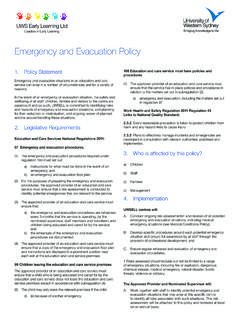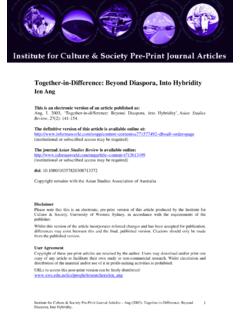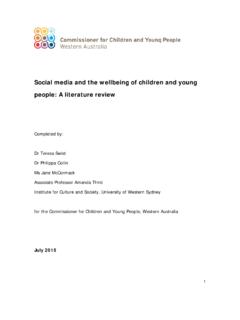Transcription of Hazard Identification, Risk Assessment And Control Procedure
1 Page 1 Hazard Identification, Risk Assessment and Control Procedure ensure that t here is a formal pr ocess for Hazard identif ication, risk Assessment and Control to effectively manage workplace and safety hazards within the Western Sydney University. Person Conducting A Business or Undertaking (PCBU) has obligations under the Work Health and safety Act 2011 (W HS Act) as well as the Work Health and safety Regulat ion 2011 (WHS Regulat ion) to manage risks to health and safety so far as is reasonably practicab le. A risk management approach involves identif icat ion and Assessment of risks foll owed by elimination of risks in the first instance or where this is not practicable, minimising those risks so far as reasonably practicable.
2 The risk management approach is im portant for three main reasons: So that the University s duty of care to i ts workers, customers, c ontractors, st udents, visitors and others thatwork or learn at the University c an be met, as part of th e legislat ive health and safety r equirements. Out of concern for the health and safety of workers, students, contractors, visitors and others at WesternSydney University workplaces. It makes good business sense and i s cost key r equirement of managing risks in the workplace is co nsult ing with workers affected by a heal th and safety matter. Workers should be involved in the Hazard identif ication, r isk Assessment and risk Control pr ocesses.
3 Where workers are represented by a Health and safety Representative (HSR), this HSR must be involved in the consultation pr ocess. The legislation also requires that where several PCBUs have duties for a health and safety matter, these PCBUs must consul t, co opera te and coordinate t heir risk management activities to ensure eff ective management of the health and safety matter. workplace Hazard identif ication, Assessment and Control is an on-going process. It sh ould be undertaken at various times, including: If it has not been done before. When a haza rd has been identified When a change to the workplace may introduce or ch ange a Hazard . Such as when changes occur to the workequipment, practices, procedures or environment.
4 As part of responding to a workplace incident, even where an injury has not occurred. Where new information about a risk becomes availa ble or concerns about a risk are r aised by workers At regularly scheduled times appropriate to the i s often more effective and easy to eliminate h azards if risk management approaches used at the planning and design stages fo r pr oducts, processes and places for work. The following Procedure for risk management (i nvolving Hazard identif ication, r isk Assessment and Control ) is a practical guide for helping make all University workplaces safer for workers, st udents, contractors, and visitors. It will help both management and workers, through consultation, to comply with the WHS regulati ons.
5 T hese regulations requi re PCBUs to identify, assess and Control hazards in the workplace with the aim of elim inating hazards or minimising hazards, do far as reasonably practicable. Recording risk management activities, including risk assessments and consultation processes is required. These procedures will assist in: Finding hazards in University workplaces. Assessing the risks that may result from these hazards. Determining Control measures to eliminate or minimise the level of the risks . Monitoring and reviewing the effectiveness of Control Page 2 3. Definitions Hazard : Anything (e .g. condition, situation, pra ctice, behaviour) that has the potential to cause harm, including injury , disease, death, environmental, property and equipment damage.
6 A Hazard can be a thing or a situation. Hazard Identification: This is the process of examining each work are a and work task for the purpose of identifying all the Hazard s which are inherent in the job . Work areas include but are not limited to machine workshops, labora tories, office areas, agricultura l and horticultural environments, store s and transport, maintenance and grounds, reprographics, and lecture theatres and teaching spaces. Tasks can include (but may not be limited to) using screen based equipment, audio and visual equipment, industrial equipment, Hazard ous substances and/or teaching/dealing with people, driv ing a vehicle, dealing with emergency situations, construction. This process is about finding what could cause harm in work task or area.
7 Risk: The lik elihood, or possibility, that harm (in jury , illness, death, damage etc) may occur fro m exposure to a Hazard . Risk Assessment : Is defined as the process of assessing the risks associated with each of the hazards identified so the nature of the risk can be understood. This includes the nature of the harm that may result from the Hazard , the severity of that harm and the likelihood of this occurring. Risk Control : Taking actions to eliminate health and safety risks so far as is reasonably practicable. Where risks cannot be eliminated, then implementation of Control measures is required, to minimise risks so far as is reasonably practicable. A hierarchy of controls has been developed and is described below to assist in selection of the most appropriate risk Control measure/s.
8 Monitoring and Review: This involves ongoing monitoring of the hazards identified, risks assessed and risk Control processes and reviewing them to make sure they are working effectively. 4. Responsibilities Effective risk management requires the commitment to WHS fro m managers and Officer as well as the input and involvement of work ers. It is the responsibility of all managers and supervisors to ensure that this policy is fully implemented in their area(s) of Control and to consult with work ers as part of undertaking the Hazard identification, risk Assessment and Control process. It is the responsibility of workers to coopera te and comply with this polic y. This includes providing effective and constructive information and feedback to aid the risk management process.
9 Officers have a responsibility to ensure that the areas under their Control are complying with legislative requirements. This includes the Of ficer understanding the hazards and risks associated with their opera tions and ensuring that appropri ate resources and processes are in place to eliminate or minimise these risks . WHS Page 3 5. Risk Assessment Procedure The risk Assessment Procedure can best be illustra ted in the foll owing way. Step 1: Identify Hazards WHS legislation in New South Wales require s that PCBUs, in consultation with work ers identify all potentially hazardous things or situations that may cause harm. In genera l, hazards are likely to be found in the foll owing; - Physical work environment, - Equipment, materials or substances used, - Work tasks and how they are perf ormed, - Work design and management In order to identify hazards the following are recommended: (i) Past incidents/accidents are examined to see what happened and whether the incident/accident could occur again.
10 (ii) Employees be consulted to find out what they consider are safety issues, . ask work ers about hazards near misses they have encountered as part of their work . Sometimes a survey or questionnaire can assist work ers to provide information about work place hazards. (iii) Work areas or work sites be inspected or examined to find out what is happening now. Identified hazards should be documented to all ow further action. The work environment, tool and equipment as well as tasks and procedures should be examined for risks to WHS. (iv) Information about equipment ( plant, operating instructions) and Materi al safety Data Sheets be re viewed to determine relevant safety precautions. (v) Welcome creative thinking about what could go wro ng takes place, what hazardous event could take place here?


